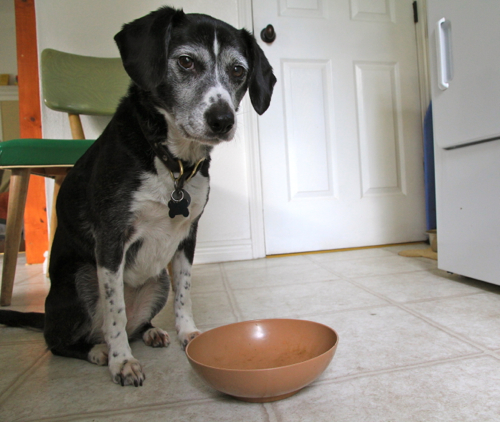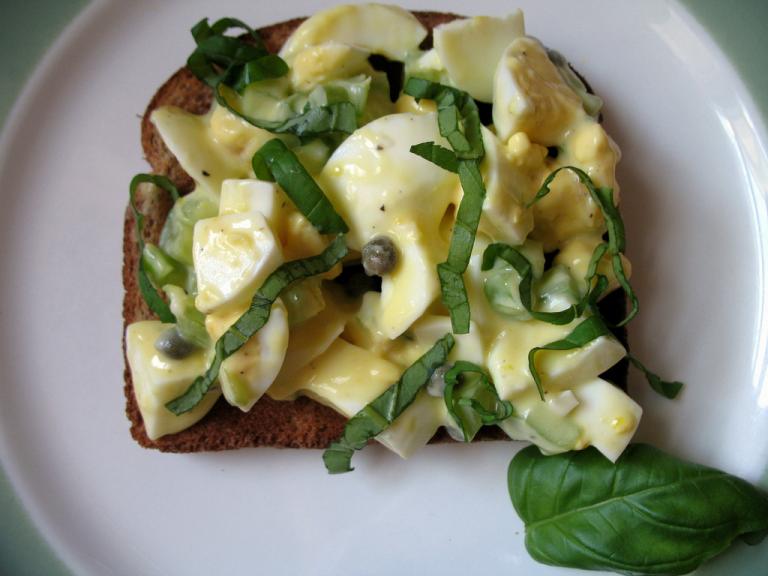Today on Grist we’re launching a series of articles about protein. What made me want to focus on protein? Well, let’s just say it started with my dog, Lucy. (That’s her over on the right.)
I’d been abstractly aware of Lucy’s meat intake when, a few years back, she started developing allergies. Like the slightly-obsessive home cook that I am, I started cooking for Lucy.
Clueless at first, I fed her portions that were around the same size as the kibble she’d been getting in her bowl for years. (At first it was chicken and rice, but I quickly replaced the rice with sweet potatoes just in case it was the grains she’d been allergic to.) And then — when Lucy growled and grumbled and harumphed — I realized my mistake: Now that her food wasn’t dehydrated, she’d need twice as much. I grimaced and pictured the astronaut food that my sixth grade classmates had passed around after returning from Space Camp in the late ’80s.
I’m not vegetarian, but the majority of the meals I cook at home are intentionally plant-based, so I was a little surprised to realize — within just a few days — that a 27-pound dog was eating more animal protein than I was. And here’s the thing: That wasn’t new.
This isn’t going to be a post that compares the energy and resource use of dogs and SUVs. Nor will it be about choosing to turn Lucy into a vegetarian (I didn’t, although I respect others’ right to do so). I’m interested in those five years wherein I — a local food devotee and generally concerned citizen — let my dog’s true protein intake, and therefore her carbon footprint, remain abstract in my mind. When I really think about it, many of us apply that same approach to high-protein foods to ourselves.
Over the course of the next few weeks we’ll be publishing a number of posts about protein from a variety of angles, starting with the basics (how much we need and how it impacts the planet). We’ll explore various high-protein foods like soy and lamb, and we’ll talk about what it means to cook with protein as a garnish or a source of flavoring rather than as the center of the meal. We’ll also explore what it means to be vegetarian in 2012. For good measure, we’ll also take a look at a few unconventional but sustainable protein sources.
Choosing between protein sources can feel a little like playing musical chairs. We know — thanks to resources like the EWG’s Meat Eater Guide — that meat and cheese are more resource-intensive and therefore have a much larger carbon footprint than most vegetarian protein sources. But there’s also an increasing amount of gray area between beef and lentils. Soy products require fewer resources in and of themselves, but they also often come out of very industrial processes. And seafood is perhaps the most tricky: Eaters weigh the choice to further deplete the ocean or support wild seafood-based or grain-based fish farming that may turn out to be a great deal like livestock CAFOs.
And, to go back to dog food for a minute, most would argue that the meat fed to pets is the stuff we humans wouldn’t want to eat. And while it’s true that ingredients like “Chicken By-Product Meal” don’t sound especially appealing on their own, I know offal-champion chefs like Chris Cosentino would balk at that response; he might say that eating the less desirable parts of the animal is actually a responsibility and a joy we’ve been deprived of in recent decades. And there’s the very real, centuries-old fact that nearly all animal parts can add flavor to food. (We’ve spoken a fair amount about the value of homemade stock on this site recently).
There are lots of strategies for reducing your (and your family’s) overall consumption of meat and other resource-intensive foods. Stock and offal aside, however, the goal with this series is not to inspire guilt about our blind spots (we all have them), but rather to encourage us all to continue stepping back to unpack the process by which our food comes to be — as mockable and tedious as it can sometime seem. Looking closely at our most popular protein sources will also remind us that they’re some of the most complex foods we have and, therefore, the ones we must avoid wasting at all costs.
What are your biggest, juiciest protein-related questions? Is there something you’d like to see in the series? Please let us know in the comments below.




